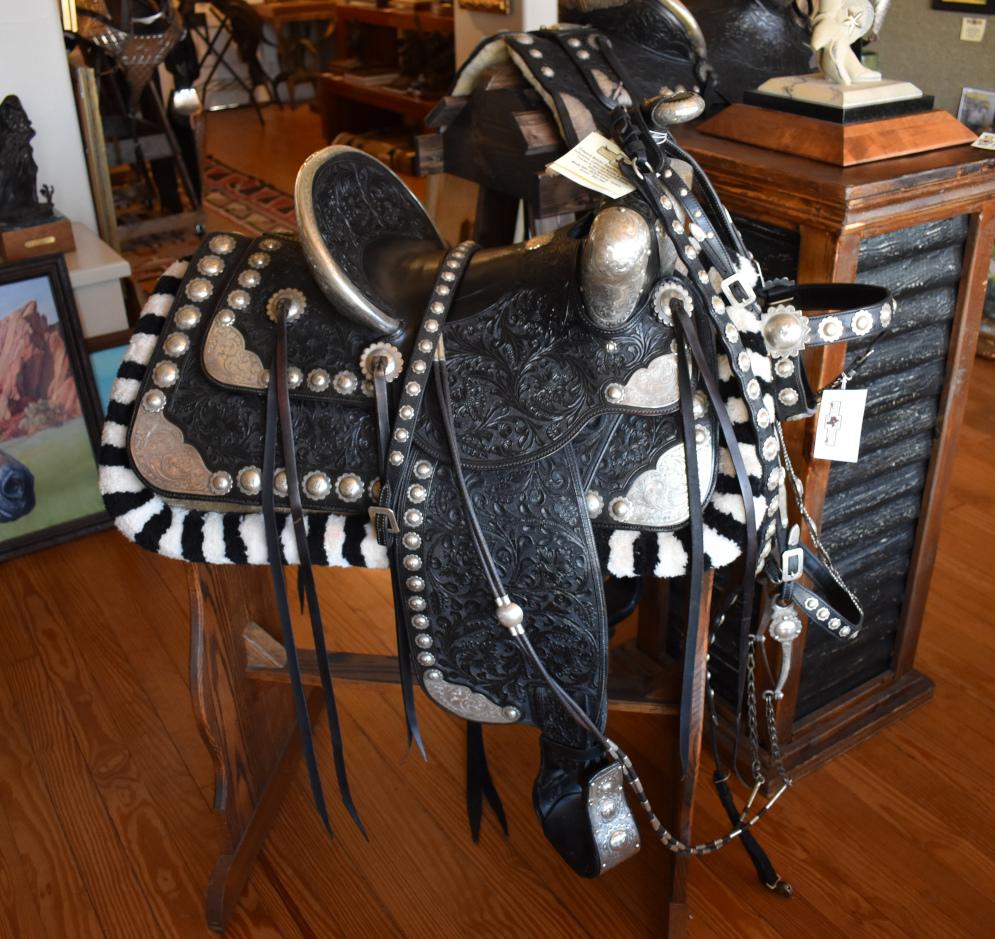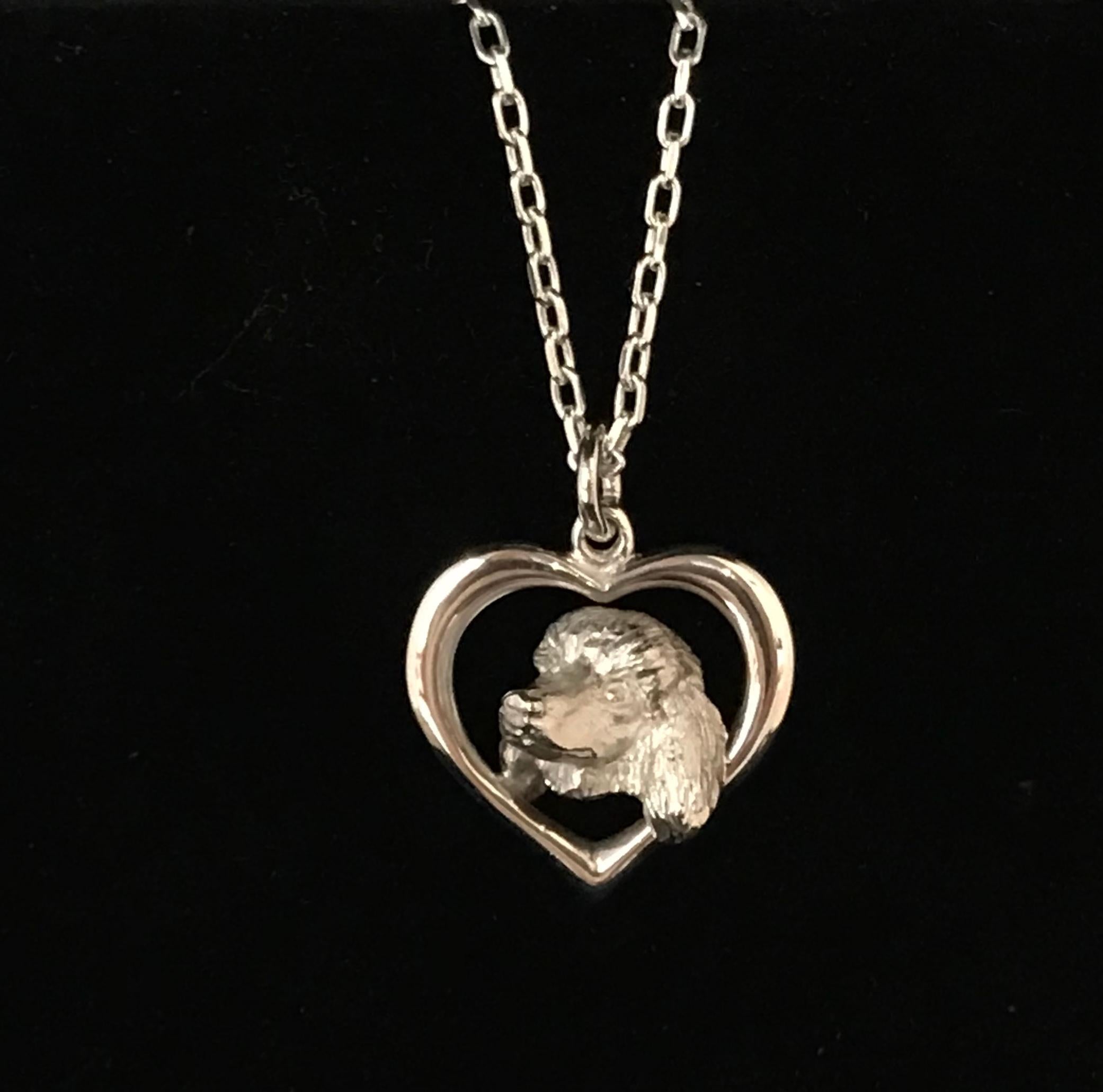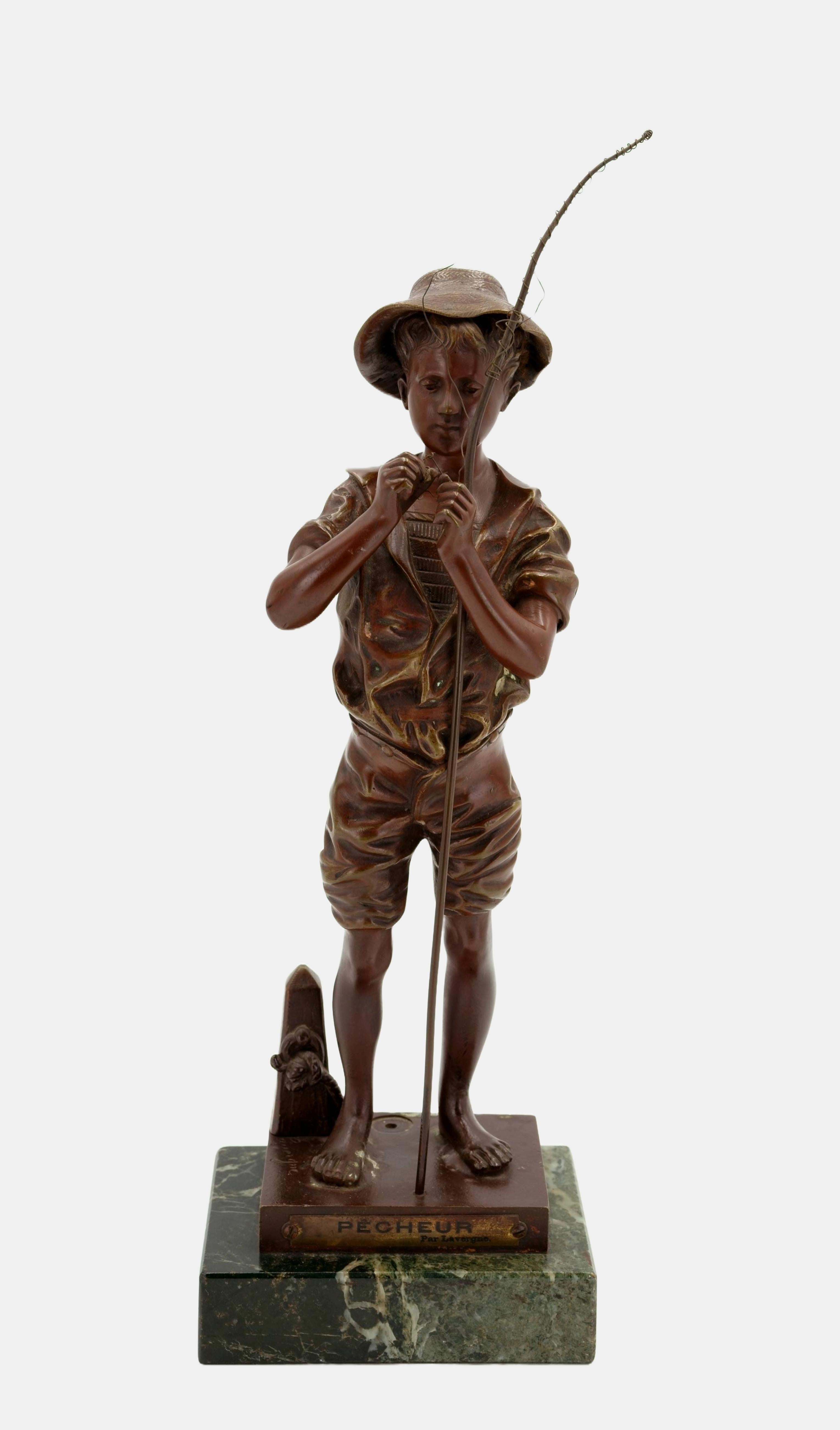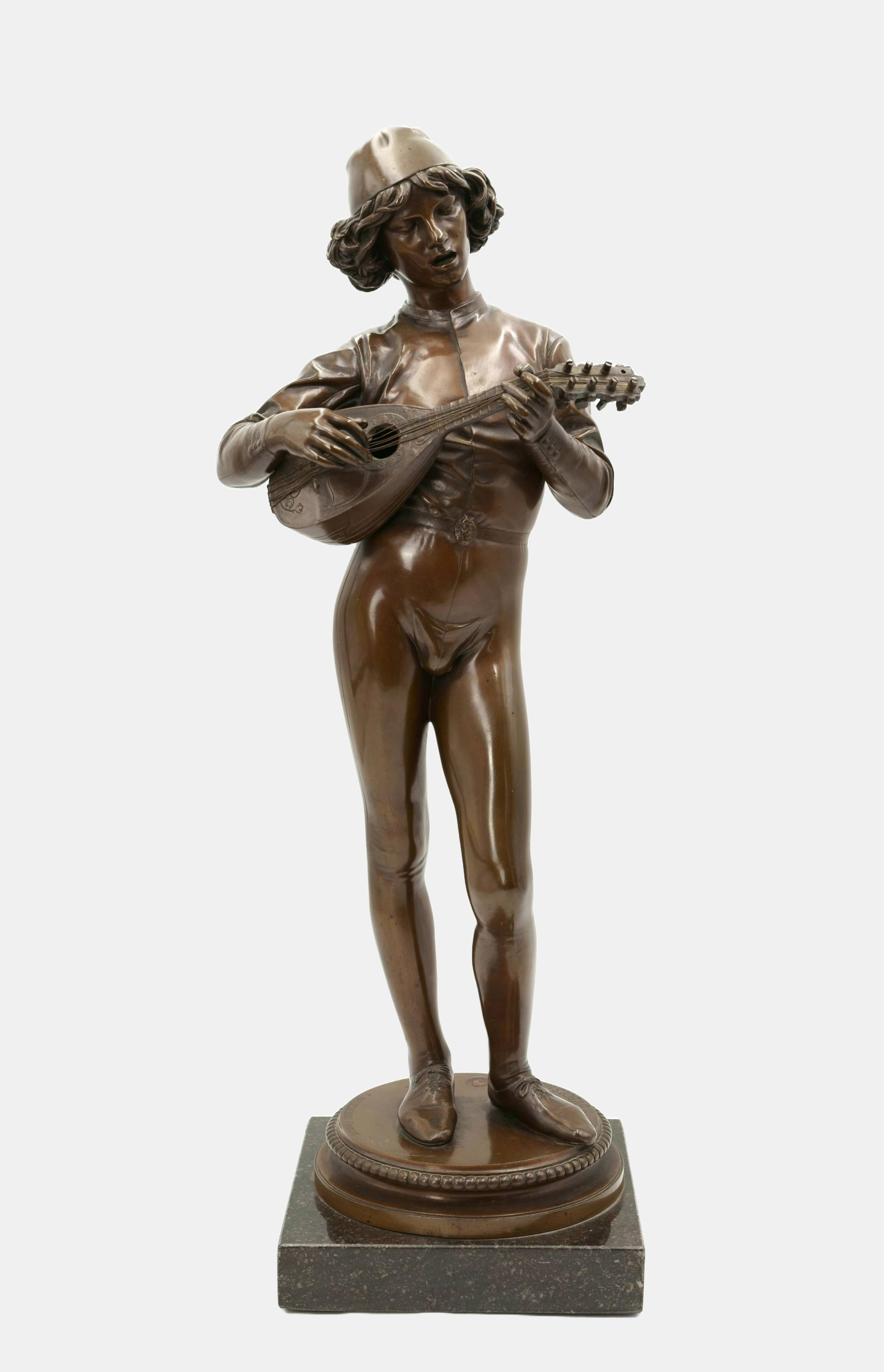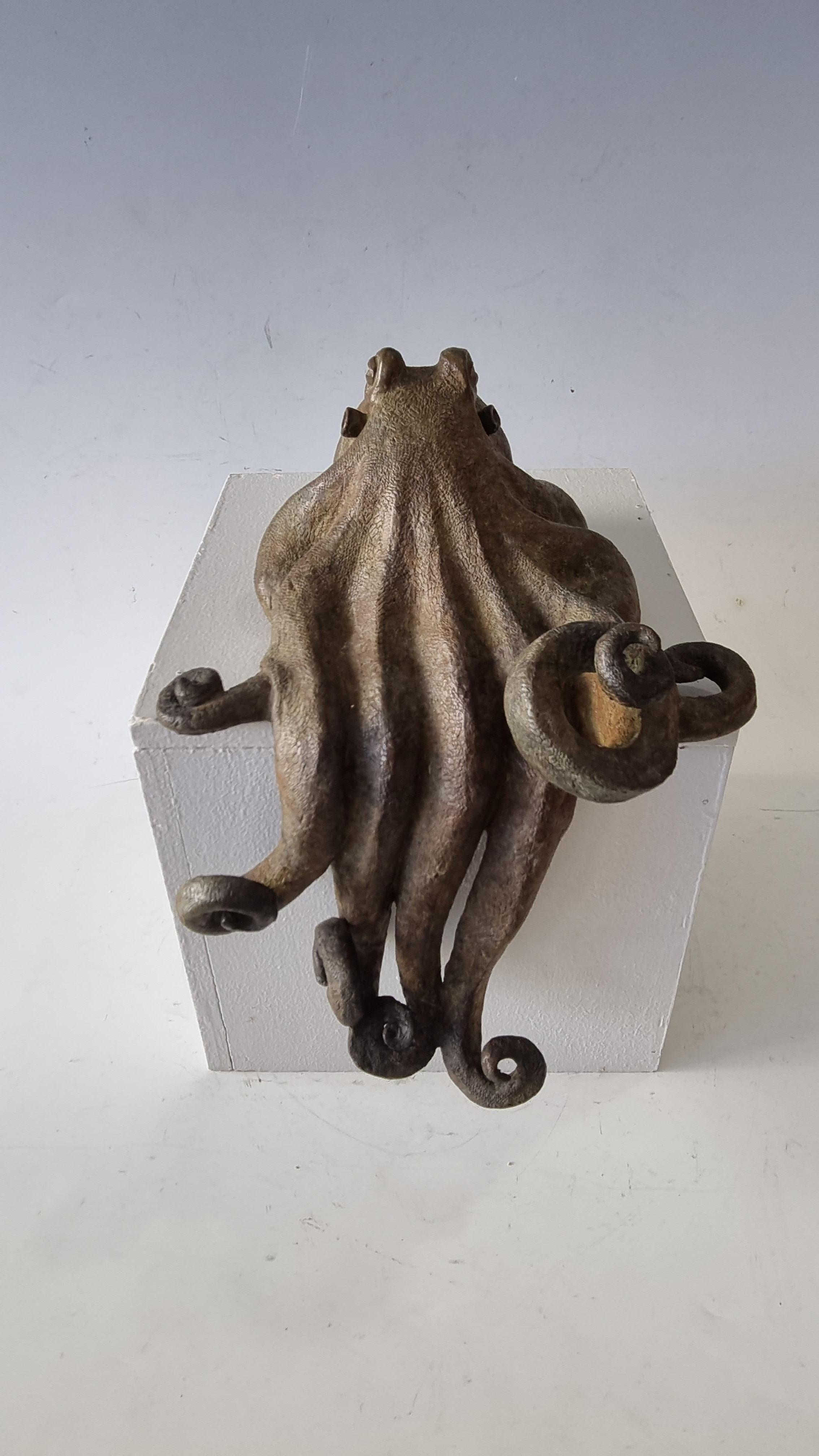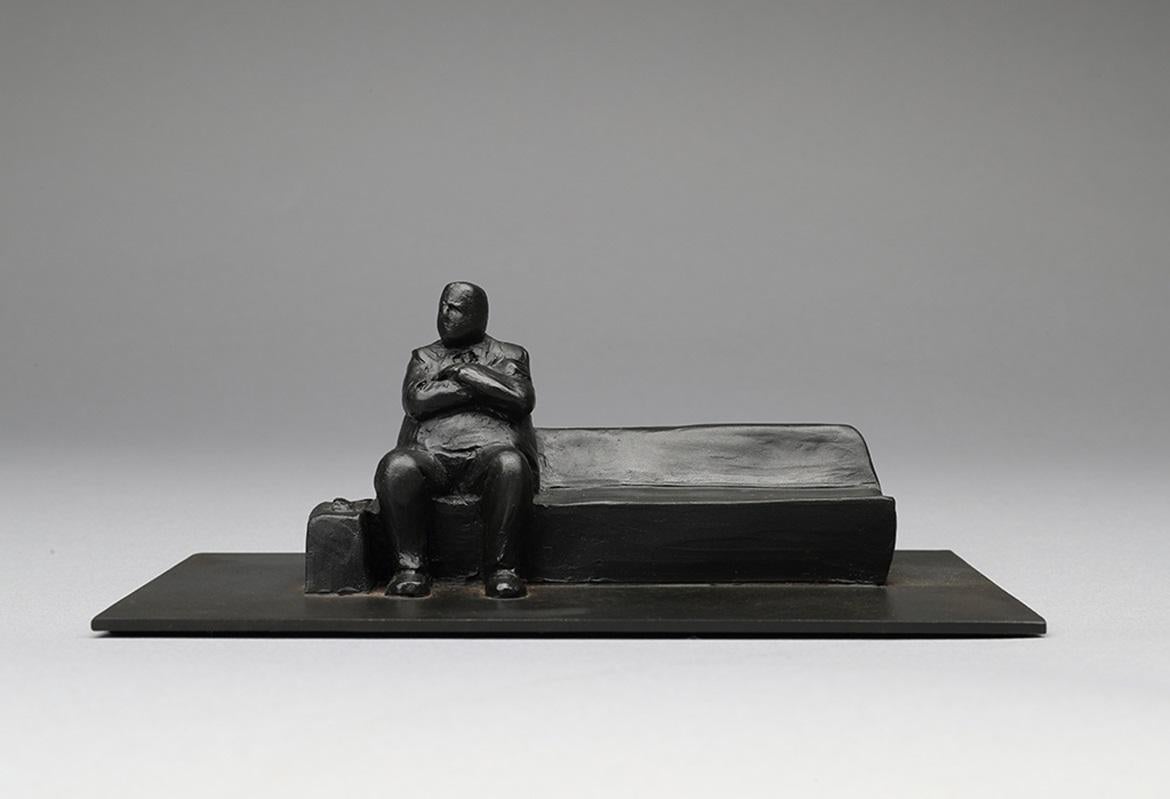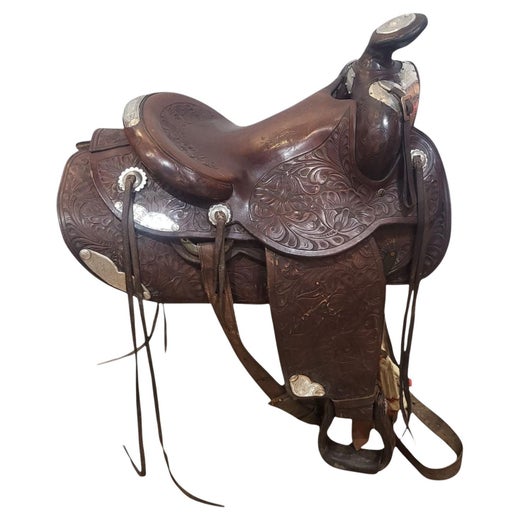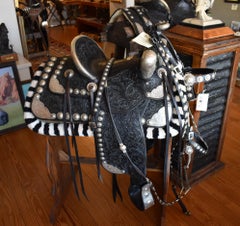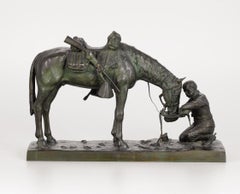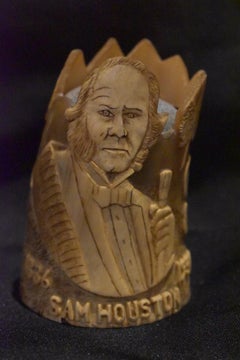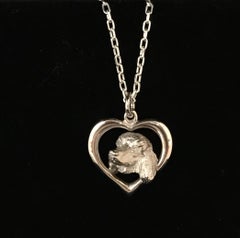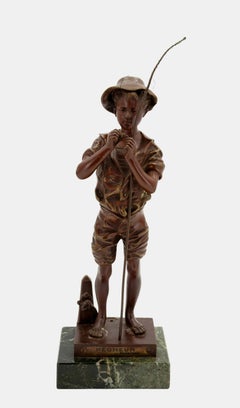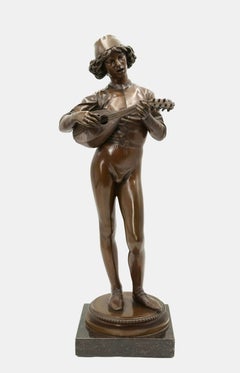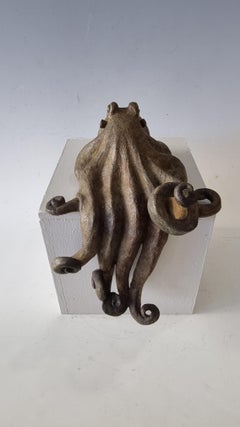Edward Bohlin silver mounted parade saddle. Black Leather. Great Bohlin Stamp. Cowboy Saddle, Western Saddle. 1940s 50s one of his most desirable periods. Bohlin of Hollywood California. He made all of the saddles and other related western gear for the movies but mostly to ride in the "Tournament of Roses Parade" Rosebowl in California. The Corona was custom made using the original Corona as the sample to copy. Here is a little provenance on this saddle:
This is a rare saddle. We think there were only five made. They were marketed to Texas Buyers when in reality there wasn't a big market in Texas. The majority of these works of art were mostly purchased by California buyers.
This saddle was formerly owned by L.D. Brinkman. After his death it was acquired by a friend of mine. I purchased it from him Jan. 1, 2024, and sold it to one of my good friends and customer Jan. 3, 2024. Sadly, he recently passed away and the saddle is on the market again.
This Saddle is depicted in the Bohlin Catalog "The Lone Star Saddle"
Lloyd Donald Brinkman (1929 – July 4, 2015) was an American businessman, cattle breeder, civic leader and art collector. He was the owner of "the largest floor covering distributor in the US," and 350 pizza parlors with Gatti's Pizza. He bred Brangus cattle, and he was a significant collector of Western art.
Brinkman was born in 1929 in near Dagmar in Sheridan County, Montana. His grandparents were Danish immigrants who became homesteaders in the county.
Brinkman graduated from Pascagoula High School in Pascagoula, Mississippi. He attended Pearl River Community College, and he graduated from the University of Southern Mississippi, where he earned a bachelor's degree in marketing in 1952.
Brinkman initially worked in the flooring industry, even starting his own business in Dallas, Texas in 1960. It eventually became "the largest floor covering distributor in the US." Brinkman was also the owner of Gatti's Pizza, which operated 350 restaurants by the time he sold the business for $24 million in 2004.
Brinkman was also a breeder of Brangus cattle.
Brinkman was a co-founder of the Museum of Western Art in Kerrville. He served on the board of directors of the National Cowboy & Western Heritage Museum. He also served as the chairman of the public utility board of Kerrville, Texas. He was honored as the "Citizen of the Year" by the Kerrville Area Chamber of Commerce in 1984.
Brinkman was a collector of Western art. He owned paintings by American artists like Joe Beeler, E. Irving Couse, Frank Tenney Johnson, Gerald Harvey Jones, Robert Lougheed, Howard Terpning, and Olaf Wieghorst.
Brinkman was married seven times. He had a son, L.D. "Don" Brinkman Jr., and a daughter, Pamela Brinkman Stone.
Brinkman died on July 4, 2015.
Biography of Edward Bohlin
Edward Bohlin (1895-1980)
Edward H Bohlin Company (Established 1920)
Saddlery-Saddle Maker
1895-1980
THE BOHLIN BRAND IS AS ICONIC AS THE FAMED WESTERN STARS that wore it. The late actor Richard Farnsworth sported a recognizable gold steer-head Bohlin buckle for decades, the engraving and edges worn smooth from years of daily wear, rodeo riding, and stunt work. When the Lone Ranger cried “Hi-yo, Silver!” as he rode to the rescue, both he and his white horse were equipped with Bohlin-made silver-mounted gear. Happily, The Bohlin Company that created these products in the 1940s continues today, maintaining original designs and traditions for fancy belt buckles and other jewelry in the mode of the company founder, all while innovating with new and exciting products to serve a contemporary audience.
Despite his cowboy credentials, when Ed Bohlin spoke there was an unmistakable residue of a Swedish accent that gave away his origins. He left the country of his birth when he was only 15 years old, arriving in New York in 1910 and immediately heading West, where by 1912 he was punching cattle in Montana. Four years later he was in Cody Wyoming, driving a stagecoach, working at area ranches, and learning to do leatherwork. He soon married and had a daughter, Lillian, but his wife tragically died in the influenza epidemic of 1918, leaving Bohlin alone to provide and care for his daughter.
After some crude attempts at fashioning silver and copper buckles, Bohlin opened his own leather shop in 1920. But after a second marriage failed, Bohlin – who had become proficient with twirling rope and shooting his Colt revolver – abandoned his business and joined a traveling Wild West show headed to the coast. It was just as well. His temper had gotten him in trouble with the law more than once, and it was time for him to move on.
Legend has it that during the show’s appearance at the Pantages Theatre in Los Angeles, Bohlin was approached by silent film Cowboy Tom Mix, who wanted to purchase his handcrafted calf-skin jacket. Others soon recognized the flare in Bohlin’s style, and he began to appear as an extra in cowboy movies and started making tooled leather gear for stars like Mix, William S. Hart, and others. In 1922 he opened the Hollywood Novelty Leather Shop and scratched out a living by making special pieces for film star Buck Jones and his wife Dell, who did stunt work. Major contracts to make leather outfits and harnesses for decidedly un-western films such as The Ten Commandments (1923) and Ben-Hur (1925) helped him keep solvent.
Bohlin’s firm was formally organized in Hollywood in 1926 as Edward H. Bohlin Inc. The shop moved many times over the next 19 years as the founder skillfully promoted his wares and developed some of the most enduring designs for Western-styled buckles, saddles, and accessories. He became a master of brand promotion, publishing lavish catalogs, turning his shop into a gathering place for real and imagined cowboys, and joining organizations like the exclusive men’s equestrian group, the Rancheros Vistadores, whose members then bought and displayed his products.
Bohlin’s ever expanding Hollywood associations included cowboy detective Charlie Siringo and artist Charlie Russell. He collaborated with Al Furstnow’s saddlery company, which was based in Montana but had set up a satellite shop in Hollywood, adding luxurious silver and gold embellishments to a saddle for Col. Tim McCoy, former Wyoming cowboy and first-rank cowboy movie star. Bohlin’s buckles, spurs, scarf slides, and jewelry could be spotted on Jackie Cooper, Clark Gable, John Wayne, Barbara Stanwyck, Clara Bow (the “It Girl” of the day), and scores more.
With the proliferation of low-budget western films, a new flock of performers took on the accessories of the Bohlin shop. Hopalong Cassidy (William Boyd), the Lone Ranger (Clayton Moore and John Hart), Roy Rogers, Ray “Crash” Corrigan, The Cisco Kid (Duncan Renaldo), Pancho (Leo Carrillo), Ken Maynard, and more adopted Bohlin gear for both performances and personal wear.
Even in the middle of the Great Depression, The Bohlin Company flourished, in large part thanks to the still-wealthy customers who rode in Pasadena’s Tournament of Roses Parade. Fancy silver-mounted horse gear had been used to show off finely bred horses and the gentry of California since the 1800s, and well-known Hispanic pioneer families such as the Sepulvedas and Yorbas continued to use Bohlin gear to display their prized equines well into the next century. Bohlin himself claimed to have ridden in every parade from 1922 until 1973.
Around the world, especially with the advent of television, the annual broadcast of the Rose Parade reinforced a clear image of elegant equestrian riders. The Los Angeles County Sheriff’s Silver Mounted Posse, the Long Beach Mounted Police, and many private horse groups predominantly used Bohlin gear. While the claim that The Bohlin Company made over 12,000 saddles cannot be reliably documented, the business flourished in the 1930’s and ‘40s.
A new Bohlin store opened on Highland Avenue in Hollywood in 1945; it was a one-stop shop with a full line of Western clothing, boots, gloves, hats, and anything else needed by a stylishly dressed rider or horse. Complete tack sets and riding outfits went to the Emperor of Japan, South American oil magnates, and European royalty. Bohlin-made prize buckles were awarded at rodeos on California, Colorado, and beyond, and riders from Kansas City horse shows to Indianapolis Shriner parades to Central Park riding clubs all sported Bohlin gear.
By the 1960s business began to decline, so Bohlin diversified once again, developing new products ranging from a peculiar iron camping stove to aluminum rifle cases. Inspired by his hero Charlie Russell, he turned his own hand toward bronze sculptures of Western wildlife. But the greatest creative endeavors of his waning years took him back to the beginning, designing some of the most elegant buckles and saddles in the Highland shop’s history for loyal customers, as well as for himself.
In 1996 the Autry Museum of Western Heritage staged a 5,000 square-foot exhibition of the most famous Bohlin gear and published this writer’s book Saddlemaker to the Stars: The Leather and Silver Art of Edward H. Bohlin. The Big Saddle bought and donated by Gene Autry himself was the star of the show.
A young Ed Bohlin
Edward H Bohlin Company
Saddlery-Saddle Maker
1895-1980
BP: Sweden
LKL: Hollywood, CA.
Born in Sweden in 1895, Edward Bohlin ran away from home at age 15, working his way to America on a huge four-mast schooner with dreams of Buffalo Bill Cody's Wild West in his head. Ed worked cattle drives around Montana before opening his first saddle shop in Cody, Wyoming where he did rope tricks in front of his shop to draw business. He met Tom Mix while performing at the Pantages Theatre in Hollywood and Mix convinced Ed to stay and produce silver and leather items in the Los Angeles area. From his humble beginnings to his fame in Hollywood for high-end pieces, Ed crafted more than 12,000 Bohlin saddles including many grand silver outfits of Tournament of Roses Parade fame. He also dressed many silver screen heroes and horses with his grand style of buckles, spurs and gun belts. His company was without equal among western style silversmiths building a reputation on flawless workmanship. The Edward H Bohlin company, which operated from the early 1920s through the 1980s (under Ed's watchful eye but continues to operate under other ownership), reached its apex in the 1930s when the Hollywood cowboys reigned supreme. Bohlin was a stickler for details and employed the finest silver and leather workers of his era to satisfy discriminating clients including Mae West, Hopalong Cassidy, Monte Hale, Lyndon Johnson and Ronald Reagan.
Bohlin Saddles
Ed Bohlin was known for his beautifully crafted parade saddles. A perfectionist, for good and bad, he never accepted anything less than the best craftsmanship. The leather on his saddles still squeak after 60 years. The silver requires only a cloth to clean because he used the highest grade of sterling. He and his artisans made many of the pieces by hand, especially the gold figures on his saddles. His carving was stunning and recognizable. Many of High Noon's customers remember going into Bohlin's shop as children while their fathers' purchased saddles, buckles, belts, bolos and money clips. Sometimes the kids got a special gift, too, from their dads. A few child's saddles (The Jackie Cooper model) were made to match their fathers for parades. The Tim McCoy model and others were made for the stars of the era. Fiesta was truly a work of art, both in the silver and the pictorial carving. The Murietta was one of his brilliant models, mounted with Indian and Tepee design with distant hills all done in three shades of gold. The Dicksons were used many times for riders who wanted to twinkle with silver in parades. Bohlin saddles have always been valued higher than any other maker and have kept their value throughout the years. Both riders and collectors of Western Americana still clamor for Bohlin, whether they plan to ride using them or only to display them proudly in their offices or living rooms as art.
It all started in the Wild West — Cody, Wyoming, to be exact. At the time, just a few years shy of the era known as the “Roaring ’20s,” Cody was a frontier town located on the fringes of Yellowstone National Park. The area’s wide-open ranges and rivers were teeming with wildlife, and Cody’s dusty streets were filled with cowboys, one of whom was named Edward H. Bohlin.
Bohlin followed the long-trodden path of a typical American dreamer by immigrating to the United States from Sweden at just 15 years old. He landed in New York City, but the call of the West quickly drew him out across the plains. It wasn’t long before he was a Western horse-riding, cattle-herding cowboy through and through. Bohlin opened a leather shop in Cody in 1920 that began the Bohlin Company.
Perhaps it’s fitting that a story about becoming a cowboy in the Wild West would also be a tale of making it big in Hollywood. That’s exactly what happened for Bohlin. Life’s twists and turns led Bohlin to take up a second career as a performer in a Wild West show headed to California. There he befriended movie cowboy Tom Mix. It was reportedly Mix who convinced Bohlin to try his hand at staying in Los Angeles, relocating his shop there to supply his work to the movie industry. In the decades that followed, Bohlin would become known for his beautifully intricate leather and silversmith work, designing buckles, saddles, gun holsters, and more for many of the brightest western stars of the silver screen as well as notable figures off-screen.
John Wayne and Rogers, all sported Bohlin designs in their time, but the legacy reached far beyond movie sets. Ed Bohlin rode in his first Tournament of Roses Parade in 1924, and by 1939, a majority of the parade’s equestrians outfitted their mounts in stunning tack built by Bohlin, which were seen by millions of TV viewers each year. Over the years, designs under the brand have become coveted, with many taking top dollar at auction. A Bohlin saddle from The Lone Ranger television show sold for more than $150,000 in 2018, and the Bohlin saddle for Rogers’ famous horse, Trigger, sold for more than double that amount. Some Bohlin Saddles sell in the $500,000 range.
Bohlin Through the Decades
1920: Edward H. Bohlin, a young Swedish immigrant turned cowboy, opens his first leather shop in the frontier town of Cody, Wyoming. By the mid-1920s, Bohlin has relocated his shop to Hollywood and his work is featured in adventure and western movies.
1930s: Early film stars and notable equestrians catch on to the Bohlin brand, helping to spur its popularity on- and off-screen.
1940s: Bohlin’s shop takes up residence at a prime new Hollywood location on Highland Avenue, where the company continues its track to great renown, making custom saddles and tack that are shipped worldwide. John Wayne rides in a Bohlin saddle during this time.
1950s: The Lone Ranger star Clayton Moore dons a masterpiece Bohlin gun belt befitting the famous cowboy character, but Bohlin buckles also infiltrate the horse show, parade, and professional rodeo scenes, becoming cherished pieces for everyday cowboys and cowgirls around the country.
1960s: Bohlin expands his silver and gold artistry into sculptures and more, but the focus on his high-quality saddles and belt buckles is not lost. Some of Bohlin’s most sought-after pieces are created during this time.
1970s: Business continues as usual for the Bohlin Company, but Ed himself, now reaching his 80s, slows down, eventually retiring from the company.
1980s: Edward H. Bohlin passes away in 1980, beginning a period of change for the company in which it has multiple owners. Yet the Bohlin brand maintains its high profile, even appearing in Larry Hagman’s wardrobe on the popular TV show Dallas.
1990s: The Autry Museum of the American West honors Edward H. Bohlin with an extensive exhibit and publishes the biographical book Saddlemaker to the Stars: The Leather and Silver Art of Edward H. Bohlin by James Nottage in 1996, amid uncertainty about the company’s future. Dave Marold, along with a group of investors, buys the Bohlin Company in 1999.
